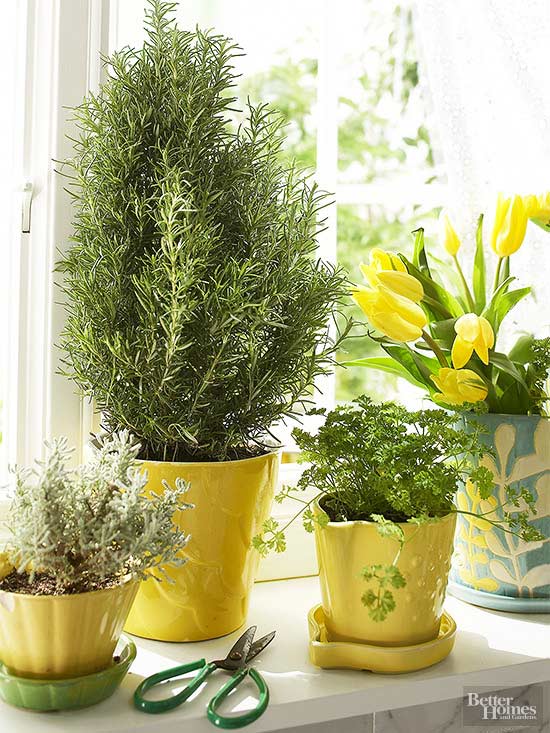






Herbs grow best in full sun and planted in well-drained soil that's kept on the dry side.
To grow herbs indoors, place them next to a south- or southwest-facing window that gets at least four to five hours of direct sunlight per day. North windows rarely get enough light for success.
For the best results -- even with a sunny window -- buy a grow-light. It's often recommended as part of an indoor herb garden kit.
continue reading belowChives, cilantro, lemon balm, mint, oregano, parsley, rosemary, and sage tolerate most indoor growing conditions. Basil is a bit trickier but worth trying. Because the herbs never get as much light as they would outdoors, they may look spindly, but the leaves still add bright flavors to salads and cooked dishes.
Water is both a friend and an enemy of herbs. Plants obviously need water to grow, but too much water rots the roots. To determine when to water, insert your index finger into the soil up to your first knuckle. If the soil feels dry, water. If it feels moist, hold off for another day.
The type of pot you choose also plays a role in how well indoor potted herbs can grow. Plastic and ceramic containers hold more moisture than terra-cotta, which is porous and breathable. Herbs often do better when grown in clay pots.
Be sure the pot holding your herbs has a drainage hole. If you use a closed pot, extra water builds up in the bottom and your herbs will die. Remember that the drainage hole is there to funnel excess water, so place a saucer or plate beneath your potted herb garden to protect the surface where you place the container. Clay saucers are great but porous, so place a ceramic, plastic, or other nonporous surface below that. Pour off any extra water that collects in the saucer to prevent waterlogged soil.
When repotting herbs, use a potting mix designed for containers. Garden soil is too heavy and doesn't have enough air pockets between particles. A potting mix designed for cactus is ideal for growing herbs as it allows water to pass through the soil quickly.
Because indoor herbs aren't receiving nutrients from garden soil and rain, they need a little bit of a boost from fertilizer. Choose a balanced formula (such as 10-10-10 or 20-20-20) or a liquid fish emulsion. Feed at half the recommended rate every other week only when herbs are actively growing. It's better to underfertilize than to overfertilize.
Surprisingly, the weather plays a role even for indoor herb gardens. If it's cool and overcast outside, water doesn't evaporate as fast as it does when conditions are warm and sunny, so adjust your watering accordingly.
Herbs like the same temperatures that people do, roughly 65 to 75 degrees F. To keep an indoor herb garden thriving during a cold winter, be sure the leaves of your herb plants don't touch the windows. Most herbs don't mind if the temperature in your house drops into the 50s at night, but basil is especially sensitive to cold temperatures. Keep basil in a spot that stays about 70 degrees F.
Get inspired by these indoor herb garden ideas.
Learn how to grow herbs indoors this winter.
Copyright © www.100flowers.win Botanic Garden All Rights Reserved